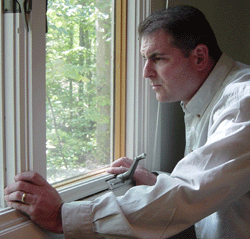Windows provide natural light and ventilation and are classified by the method by which they open and close (e.g. double-hung window). Windows are made from wood, steel, aluminum, vinyl, vinyl-clad wood or aluminum. Some modern windows have a thermal break, usually Bakelite, between the interior and exterior part of the window to prevent condensation during the winter months.
Most insulated glass units are double paned or triple-pane windows that are sealed with an epoxy to create an air gap between each plate of glass. The window frame is perforated on the inside and filled with a desiccant material that absorbs the moisture vapors from between the glass plates. The wider the dry space, the greater the insulating value of the unit. Manufacturers also use a coating over the glass for greater energy efficiency. the coating is often called low-emissive or low E glass. Low E glass reflects radiant heat in the summer and retains interior heat in the winter. Very few manufacturers hermetically seal or create a dry air gap between the panes and then use an air tight seal. America's Home Inspections has seen more window companies switch from hermetically sealing the window to using the epoxy and desiccant method.



